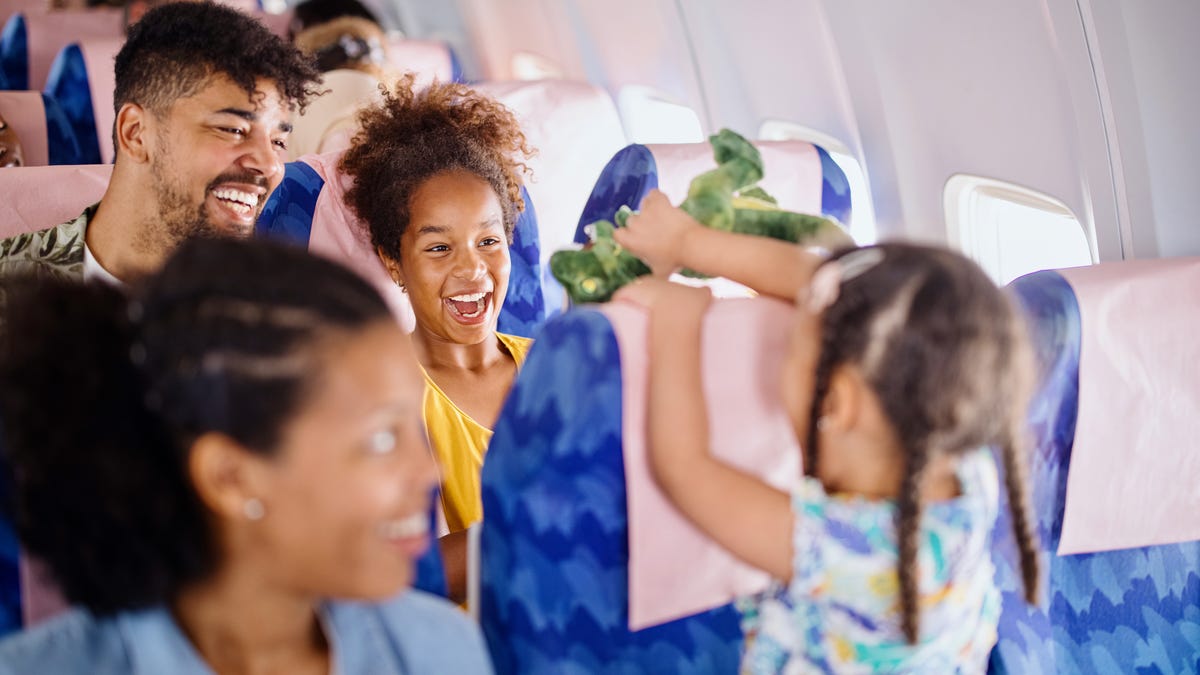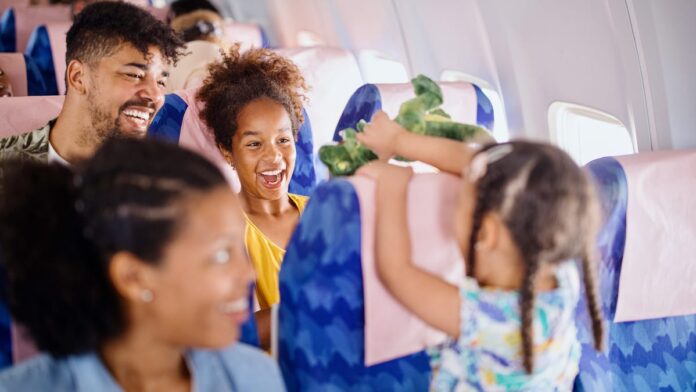
Free in-flight Wi-Fi is becoming increasingly common, largely thanks to efforts from satellite internet providers. Whether you’re staying on top of travel plans, keeping your kids entertained during a long flight or catching up on Love Island mid-flight, you have more than a few options these days.
In most cases, in-flight Wi-Fi comes by way of a satellite connection between the airline’s fleet and a third-party internet provider like Starlink or Viasat. Don’t expect fast speeds by any stretch, and if you’re trying to send or receive texts over cellular airwaves, you can only do so with an internet-based messaging system like WhatsApp or iMessage. But if you’re just looking to send a few quick emails or check Instagram, in-flight Wi-Fi should be able to get the job done.
If you have a T-Mobile Experience plan, you can get free in-flight Wi-Fi on nearly all flights with major airlines like American, Alaska, Delta and United.
Prices and terms vary from airline to airline (and in some cases, from flight to flight), so it isn’t always easy to know if your flight will offer Wi-Fi or whether it’ll be free. That’s where this post comes in. Below, we’ve listed the top 10 airlines in the US and detailed their respective Wi-Fi offerings and costs to help you keep things straight as you book your next trip. If policies change, we’ll update this rundown accordingly.
For more travel tips, check out 12 essential items to remember to pack on your next trip, and how to save money on travel despite rising flight costs.
Which airlines have free Wi-Fi?
Hawaiian Airlines and JetBlue offer free Wi-Fi, but others charge a fee. Click on a specific airline below to read more details.
Alaska Airlines
- In-flight Wi-Fi: Yes, on most flights
- Wi-Fi cost: Usually $8, sometimes as high as $25
- Streaming video: Yes, for flights equipped with “Streaming-Fast Wi-Fi,” no, for flights equipped with “Basic Wi-Fi”
- Texting: Yes, no purchase necessary (no SMS)
“On most flights, our streaming-fast satellite Wi-Fi is available for only $8,” reads the Alaska Airlines in-flight Wi-Fi FAQ page. The site adds that some of the airline’s shorter flights — specifically those using select 737-9 Max aircraft or all Q400 aircraft — are not yet equipped with an onboard internet system. Alaska Airlines also cautions passengers about the possibility of brief outages in the satellite signal midflight and adds that satellite Wi-Fi is unavailable above the Arctic Circle and parts of Alaska or when flying over certain regions of Mexico, Hawaii and Costa Rica.
In addition, Alaska Airlines offers a catalog of free in-flight movies and TV shows and free texting to all passengers connected to the in-flight Wi-Fi network, even those who aren’t paying for full web access. However, your app options are limited to iMessage, Facebook Messenger and WhatsApp. SMS messages aren’t supported, nor can you send photos or videos. Additionally, Alaska Airlines doesn’t allow passengers to make voice or video calls via apps like FaceTime or Zoom.
The airline also differentiates between “Streaming-Fast Wi-Fi,” allowing passengers to stream, chat and browse the web, and “Basic Wi-Fi, ” which doesn’t support streaming or uploading large attachments. Here’s the list of aircraft that support the faster, first option:
- All Boeing 737 Max aircraft
- All Boeing 737-900ER aircraft
- One Boeing 737-900 aircraft
- All Boeing 737-800s aircraft
- All Embraer E175 aircraft
And here’s the list of aircraft offering slower, Basic Wi-Fi, which doesn’t allow for streaming:
- All Boeing 737-700 aircraft
- One 737-900 aircraft
Alaska Airlines also notes that the price of Basic Wi-Fi on Boeing 737s varies and can cost up to $25. Monthly and yearly internet subscriptions are also available for frequent travelers. Meanwhile, if you have a T-Mobile Experience mobile plan, you’ll likely be eligible for free in-flight Wi-Fi on Alaska Airlines flights.
Allegiant Air
- In-flight Wi-Fi: No
Wi-Fi isn’t available on any Allegiant flight, the airline notes on its FAQ page for in-flight services, nor does Allegiant offer its own catalog of movies and television shows for in-flight entertainment. You can get two beers and a single-serve meat-and-cheese tray for $26 though, so you’ve got that going for you.
American Airlines
- In-flight Wi-Fi: Yes, on select domestic flights
- Wi-Fi cost: “As little as $10”
- Streaming video: Yes
- Texting: Yes (no SMS)
American Airlines touts the availability of “upgraded, high-speed Wi-Fi” on its travel info site, but only on select domestic flights. You’ll need to check your flight status to see if Wi-Fi is included with your trip. If it is, you’ll be able to pay a fee to connect and browse the web, check emails and send messages, or stream video from services like Netflix, Hulu and HBO Max.
That fee can vary from flight to flight, but American writes that it’s available on most routes starting at $10. AAdvantage members can also purchase a Wi-Fi subscription plan that costs $50 per month for a single device or $60 per month for two devices. T-Mobile customers with the Experience plan can also enjoy full-flight Wi-Fi with their plan on American flights.
According to the in-flight internet terms of use, American’s onboard Wi-Fi is provided by Gogo, Viasat and Panasonic.
Delta
- In-flight Wi-Fi: Yes
- Wi-Fi cost: Free for SkyMiles members, $10 for nonmembers
- Streaming video: Yes
- Texting: Yes (no SMS)
With service provided by T-Mobile, Delta currently offers free in-flight “Delta Sync Wi-Fi” on most flights for Delta SkyMiles members. To find an aircraft with Wi-Fi, you can check Delta’s in-flight guide.
Notably, non-SkyMiles members can access Wi-Fi for free on select aircraft thanks to satellite internet provider Viasat and Wi-Fi Onboard. Aircraft you can get free Wi-Fi on include:
- Airbus A220-300
- Airbus A319
- Airbus A320
- Airbus A321ceo
- Airbus A321neo
- Airbus A330-900
- Airbus A350
- Boeing 737-800
- Boeing 737-900
- Boeing 757-200H/D
If you’re not a SkyMiles member or flying on an aircraft different from those listed above, you’ll need to pay a $10 fee for Wi-Fi access. Daily and monthly Wi-Fi subscriptions are available for frequent flyers, and some Delta flights also support in-flight Wi-Fi for those on the T-Mobile Experience plan.
Frontier Airlines
- In-flight Wi-Fi: No
Frontier doesn’t offer in-flight Wi-Fi or on-demand entertainment on any of its flights. That also means that there’s no way to send texts while in the air on a Frontier flight.
“The lack of these services and electrical outlets on our flights means cost savings and the lowest fares possible can be passed on to our customers,” the company’s in-flight FAQ page reads.
Hawaiian Airlines
- In-flight Wi-Fi: Yes
- Wi-Fi cost: Free
- Streaming video: Yes
- Texting: Yes (no SMS)
Hawaiian Airlines recently struck a deal with Elon Musk’s Starlink satellite internet service to offer free in-flight Wi-Fi on all flights. Like most airlines, video calls, voice calls and texts sent through SMS are not allowed on-flight. But you can do pretty much anything else with a Starlink internet connection, like streaming your favorite shows. You don’t need a special app or a credit card; just connect to the “Starlink Wi-Fi on HawaiianAir” network, and you’re online.
Hawaiian Airlines is still rolling out in-flight Wi-Fi on its Boeing 787 aircraft, in partnership with SpaceX and Boeing.
JetBlue
- In-flight Wi-Fi: Yes
- Wi-Fi cost: Free
- Streaming video: Yes
- Texting: Yes (no SMS)
Before Hawaiian Airlines offered in-flight Wi-Fi for free, JetBlue was the only major airline service to offer that amenity to its customers. JetBlue offers “high-speed” Wi-Fi through Viasat. You must navigate to FlyFi.com to connect your device to the network. Passengers can use it to browse the web, send messages and emails or stream video. JetBlue also offers full access to Peacock during flights.
Southwest
- In-flight Wi-Fi: Yes
- Wi-Fi cost: $8 per device
- Streaming video: No (movies and TV shows are available on-demand free of charge, including select live TV channels)
- Texting: Yes, no purchase necessary (no SMS)
Not all of Southwest’s aircraft are outfitted with Wi-Fi networks, but those that are offer passengers free access to movies and on-demand TV shows, including select live programming, as well as free music through iHeartRadio and free texting via iMessage or WhatsApp.
Passengers can pay $8 per device for full web access, which adds in browsing, but due to bandwidth constraints, you won’t be able to stream video from Netflix, Hulu or other services, nor will you be able to use video-conferencing software like Zoom or Microsoft Teams.
Spirit Airlines
- In-flight Wi-Fi: Yes
- Wi-Fi cost: $6 to browse/text, $8 to stream
- Streaming video: Yes
- Texting: Yes (no SMS)
Spirit promises to offer the fastest in-flight Wi-Fi of any airline based in the US, with advertised speeds topping out “up to 400Mbps.” That’s pretty fast for in-flight Wi-Fi that gets online via satellite, but you likely won’t get more than 7 to 10Mbps during your flight. Spirit uses Thales’ SES-17 satellite system to provide coverage for travelers.
Browsing and sending messages requires a $6 fee per device and you’ll need to make that $8 if you want a connection that’s fast enough to stream video. Wi-Fi is available across most of Spirit’s fleet, including all of its Airbus A320 and A321 planes, though the company is still rolling out connectivity to Airbus A319s.
United
- In-flight Wi-Fi: Yes
- Wi-Fi cost: $8 (or 800 miles) for MileagePlus members, $10 for nonmembers
- Streaming video: Sometimes
- Texting: Yes (no SMS)
United offers in-flight Wi-Fi for most North American flights by way of four separate providers: Gogo, Panasonic, Thales and Viasat. That’s slated to change soon. United plans to partner with Starlink in 2025 to test in-flight Wi-Fi and eventually pivot to using Starlink for all flights.
In most cases, the cost to connect is $8 (or 1,600 miles) for MileagePlus members and $10 for everyone else, though United cautions that those prices could be higher on some of its longer international flights. Once connected, you’ll be able to browse the web and send messages via supported apps, including iMessage, WhatsApp and Messages by Google.
Most flights won’t allow you to stream video directly from sites like YouTube and Netflix, so instead, you’ll have to watch movies and TV shows from your flight’s free onboard entertainment catalog. However, you can stream video on select Airbus 319 and Boeing 737 aircraft within United’s fleet, including the 737 Max 8 and 9 and Boeing 757-300s.
If you have a T-Mobile Experience plan, you’ll also be eligible for free in-flight Wi-Fi on United Airlines flights.
For more, check out our tested picks for the best Wi-Fi routers, and how to tell if your router is in the wrong spot.
Airplane Wi-Fi FAQ
Is there an airline with free Wi-Fi?
Yes, Hawaiian Airlines and JetBlue offer Wi-Fi service at no charge. However, Delta Airlines offers its SkyMiles members free Wi-Fi; otherwise, nonmembers will have to pay $10.
How much does Wi-Fi cost on a plane?
Prices and terms can vary from airline to airline and with your flights as well. However, as seen with the airlines mentioned on this page, WI-Fi service can start anywhere between $6 and $25, with Alaska Airlines being the most expensive at $25 on some flights.
What happens if you use Wi-Fi on a plane?
You will likely incur a fee for using your airline’s Wi-Fi service, though there are a few exceptions, such as Hawaiian Airlines and JetBlue, which offer free Wi-Fi. Most airlines offer Wi-Fi service that is supported by satellite internet, which means your speeds will be slower than your traditional home broadband connection. On the bright side, you should have enough speed for basic messaging via WhatsApp or iMessage, sending emails and scrolling through Instagram.


